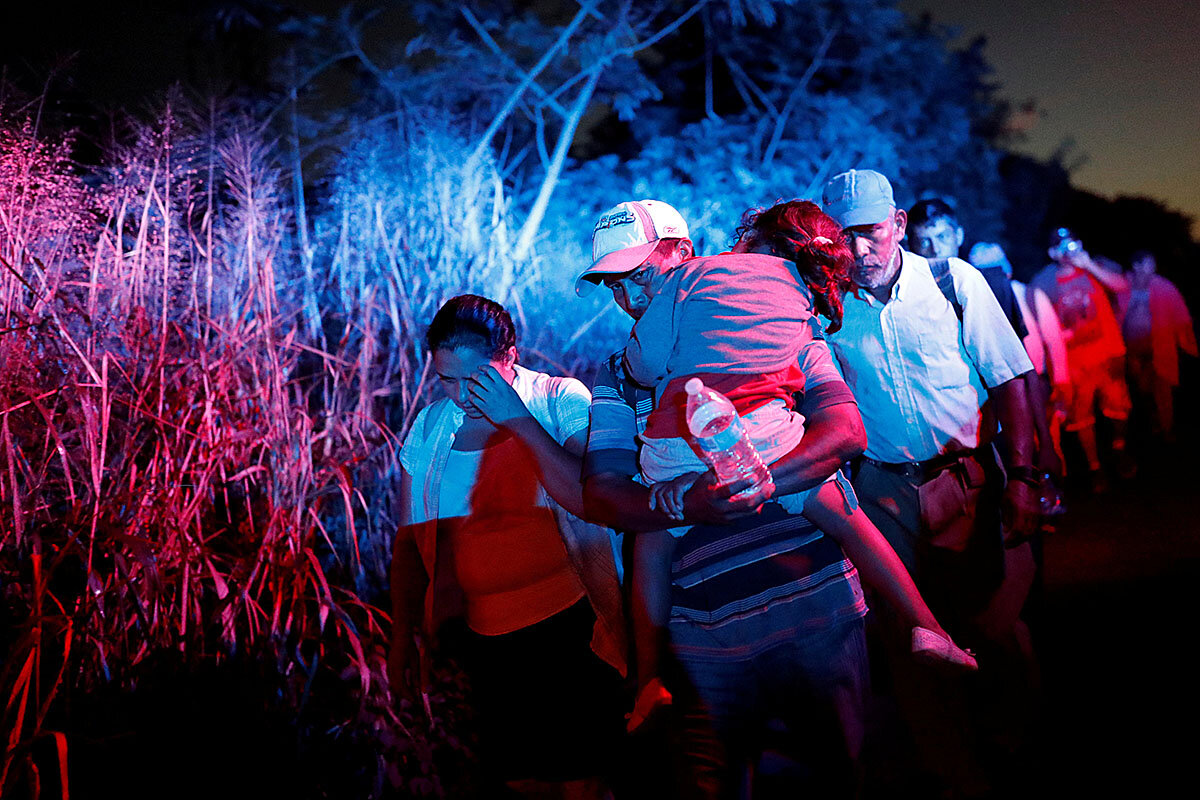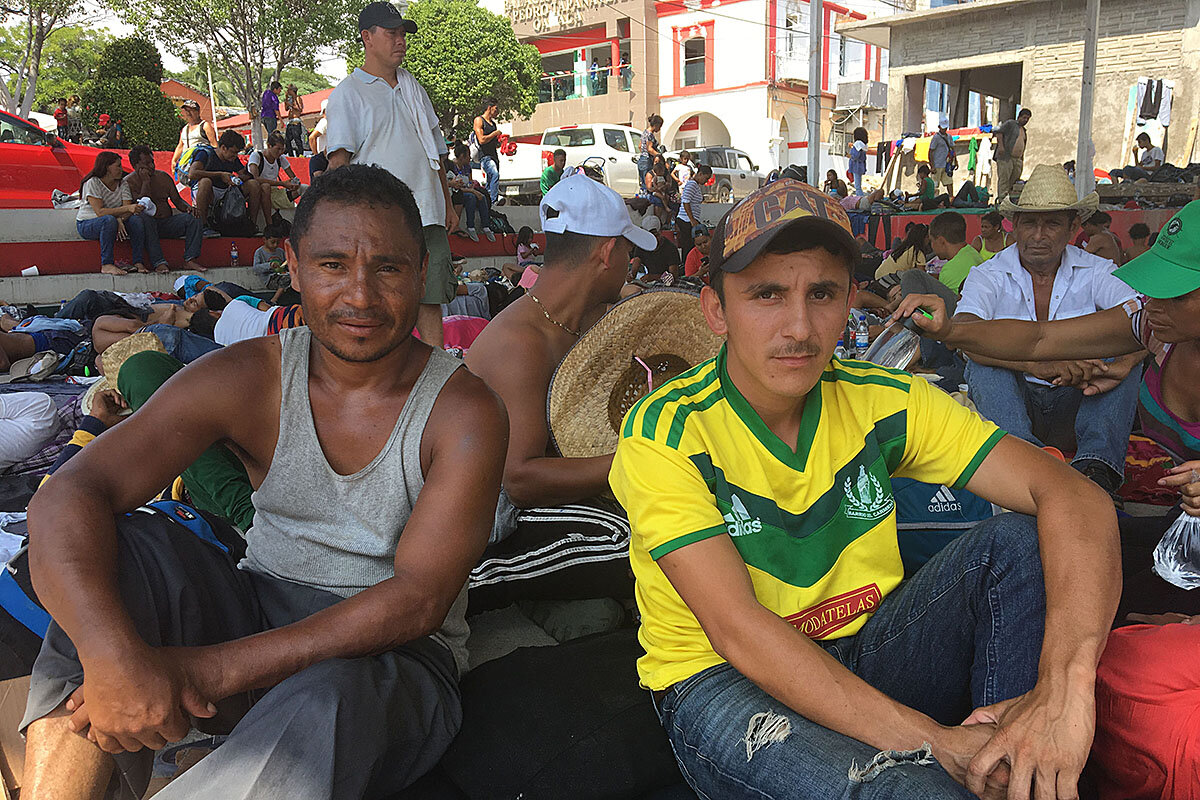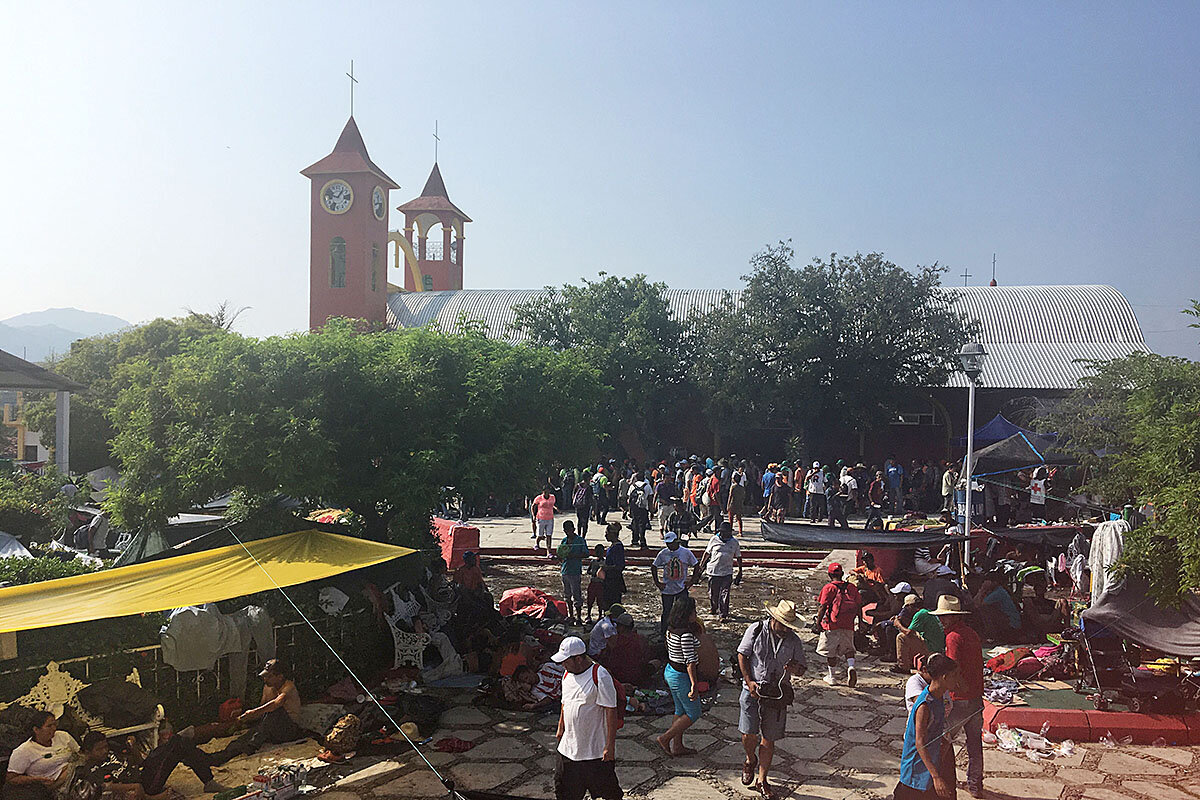Between migrants and US border, an information gap of many miles
Loading...
| San Pedro Tapanatepec, Mexico
Carlos Palacio, a lanky mechanic in his early 20s, sits on a piece of cardboard on the edge of this Oaxacan town square, hiding from the sun. His eyes are heavy and droplets of sweat form on his brow. Mr. Palacio has traveled more than 600 miles with his girlfriend, little brother, and three other family members since early October. They fled their home in Tegucigalpa, Honduras, where the only future he envisioned was forced gang recruitment and an early death.
For Palacio, and most of the estimated 5,000 migrants traveling north together across Mexico this month in a caravan, the US serves as a beacon. It motivates him to continue waking before dawn to avoid the blinding heat, sleeping wherever he can, and relying on the kindness of locals to keep his family safe, hydrated, and fed. More than 2,000 miles still stand between him and the US border crossing in Tijuana.
But when Palacio envisions El Norte, it’s not a land of plenty. In fact, his “American Dream” is mostly defined by what it lacks: widespread homicides and gang activity, debilitating unemployment rates, and corrupt police.
Why We Wrote This
Making public policy work isn’t just a matter of enforcing it. Policies also need to be communicated clearly. With US border policy, that’s more complicated than it seems. Part 4 of On the move: the faces, places, and politics of migration.
“I’ll apply for asylum and enter the US legally,” he says, noting that he doesn’t have a Plan B if the US denies him entry. “I can’t go back to Honduras.”
This summer, the US took new steps to tighten its border, separating parents and children in an effort to dissuade others from setting out on the journey themselves. But compared to past decades’ migrants, most of whom primarily sought economic opportunity, many today seek refuge from threats, violence, and repression – motivations that are harder to break, and make US warnings less effective. The gap is growing between messages the US intends to send to would-be migrants – like plans for a 2,000-mile border wall, or declaring that gang-violence is not grounds for asylum – and the information people receive and believe.
“I think US government officials are often naïve about how little access to accurate information Salvadorans, Guatemalans, and Hondurans have,” says Elizabeth Kennedy, a social scientist who researches migrants and deportees in Central America. Only about 15 to 30 percent of these Central American nations , for example.
In many ways, the information gap has created the situation we’re in today. One where thousands of migrants and refugees trust they’re trekking toward potential safety in the US, protected by their faith in God, and often with few concrete ideas of what life will look like if they are permitted to cross the border. And one where the US government sees the migrants as an oncoming invasion, deploying more than twice as many soldiers as it has fighting ISIS terrorists in Syria, and reportedly is , like forcing parents to choose between being detained with their children or turning them over to foster care.
“In 2012, 2013, people passed through here with plans and life projects” laid out for the US, says Sister Magdalena Silva, who directs a shelter for families, women, and children in Mexico City called Cafemin. “People are arriving now with no plan. They left home in the moment they realized they couldn’t remain a second longer and their only hope is to get to the US border” and figure it out from there, she says.
“The US continues to be this ideal attracting them,” Sister Silva says.
Transmission trouble
When 16-year-old Michael heard on the local news that a migrant caravan was taking off from San Pedro Sula, Honduras, last month, his interest was piqued.
“Schools are easy recruitment centers for gangs,” he says of his main drive for leaving the mountainous capital, Tegucigalpa. “I’m scared all the time, but I was never brave enough to leave on my own.” The trek north through Mexico is notorious for its risks: kidnapping, extortion, trafficking, and death.
He started to get phone calls: His friend Edwin, sitting beside him after completing today’s 28-mile trek, asked if he was considering joining the caravan. Then Julia called, then Walter, then Junior. He banded together with this small group of friends, who decided now was the moment to take their shot at a new life.
“I’m just hoping [the caravan] can make some kind of deal” with the US to enter legally, he says; or perhaps, at least, minors like him will be allowed to stay. He doesn’t follow US news and migration policy changes closely, he says – since leaving Honduras he’s focused any time on the internet to talking with his parents on Facebook. But other migrants in the group share what they know with him.
“I have a question for you, though,” the teen says, his voice cracking. “Do you think Trump is going to let us in?”
How information is transmitted and interpreted by would-be migrants isn’t very well understood, experts say. Most people rely on information from those who have migrated before, like tips about what route to take, or whether it’s the “right moment” to try one’s luck coming north. Friends and family already in the US are relied on to read the tea leaves of US policies. Sometimes official US information conflicts with what an aunt or sibling is sharing, and people tend to trust their families.
“In general, migrants are pretty rational actors,” says Dorris Meissner, a senior fellow at the Migration Policy Institute in Washington. But “like all of us, they often think they are the ones who are not going to be harmed.... It’s a very human tendency.” In addition, there’s a sense of “get in while you can, before they come up with something new,” a feeling that’s compounded by more drastic policy changes, like last spring and summer’s “zero tolerance” approach.
“The way people get news in the region is through word of mouth. So, what the US might think is being effective usually is not,” Dr. Kennedy says, referring to official channels like embassy notices and press releases. And many Central Americans’ lack of faith in local government officials and media shapes how they digest messages from governments abroad, as well.
“Even if there is an explicit message, because of how corrupt the media and politicians are in El Salvador, Honduras, and Guatemala, [locals] will sometimes think, ‘Oh, so the exact opposite is true,’” she says. In 2014, when the US was telling Central Americans not to come, “Many Salvadorans took that to mean ‘[the US] just can’t have as many,’ ” she says.
Many researchers and observers say the US’s recent zero tolerance policy didn’t discourage migration. There was an uptick in migration before Trump took office, then a several-month drop off after his inauguration. But numbers started to climb again last spring, largely consisting of families and minors. Despite the family separations last spring and early summer, the many families in this current caravan of migrants say they believe now is their chance to ask Trump and the United States for help.
Bernadina Diaz, who is traveling with her three children between 12 to 16, has banded together with two other single mothers that she met since fleeing Progreso, Honduras, last month.
She says she was horrified by the family separations – but they aren’t deterring her. “It was just a day or two of separation, right? I can manage that for long-term safety and a dependable job,” she says, sitting under a plastic tarp and eating beans and rice, after arriving here in 104-degree heat. When she’s told that many of the parents split from their kids last summer , her face drops.
“I can’t think about that. If I think about what’s to come, I’ll lose the power to go on,” Ms. Diaz says. “I have to believe God is watching over us.”







